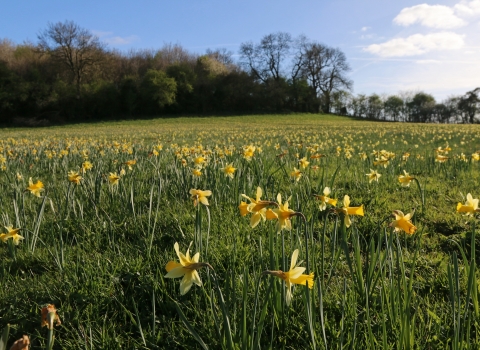
Hill Court Farm by Paul Lane
Hill Court Farm & The Blacklands
Location
Know before you go
Dogs
When to visit
Opening times
Permissive path open dawn to duskBest time to visit
All year roundAbout the reserve
Longdon and Eldersfield Marshes were once Worcestershire’s largest and most important wetland; haunt of otter, bittern, swallowtail butterflies and rich flora. In late Victorian times the marshes were drained for agriculture. Although remnants exist, much of their former glory has been lost. In 1867 the naturalist Edwin Lee wrote: “Longdon Marsh is covered with water in a wet autumnal season and at that time assumes the appearance of an extensive lake. Even in summer a few days of continued rain inundates these flat meadows... In autumn the marsh is covered with geese, and the ground, white with feathers, presents a strangely barren aspect amidst the cultivated country that slowly advances on its lessening borders.”
In 2001 the Trust purchased the 120 hectares of Hill Court Farm and the Blacklands. At the time it was being managed as an intensive dairy and arable farm; we undertook initial restoration works to recreate grasslands and to raise spring water levels but the habitats will take many years to develop and mature. We aim to recreate the grazing marshes, wetlands and wildlife-friendly farmland to provide suitable breeding habitats and wintering grounds for birds such as lapwing, redshank, wildfowl and farmland birds like skylark and yellowhammer.
The reserve was named in honour of Andrew Fraser, the Trust’s Conservation Manager for almost 30 years, who sadly died in 2003. The purchase and establishment of this reserve was made possible with funding from The National Lottery Heritage Fund, English Nature, Worcestershire County Council, Severn Waste Services, the Environment Agency, DEFRA and Aquila Networks.
Bigger, better and more joined up
We believe that a landscape-scale approach to wildlife conservation is essential. Wildlife needs space to adapt and move to cope with the consequences of climate change. Practically, this means that we need our countryside to be bigger, better and more joined up to provide a coherent network of large areas linked by corridors that can provide benefits for people as well as for biodiversity.
This is an adventurous project with on-site development of water management systems with no adverse impact on neighbouring sites. The restoration of the marshes in this area is being taken forward by acquiring land to establish core nature reserves and we are encouraging other landowners on the marsh to adopt more wildlife-friendly management of their land. The Trust has identified the Severn & Avon Vales area as one seven priorities in Worcestershire for its Living Landscapes approach. Here, we have been working as part of a broader partnership focused on the Severn and Avon Vales; Longdon & Eldersfield Marshes form the largest priority zone within the Severn & Avon Vales Living landscape area.


